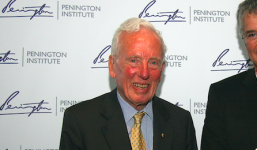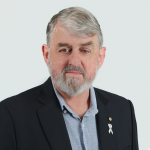Country-Based Drug Treatment: An Interview with Professor David Penington

In late October, Victorian premier Daniel Andrews approved a two-year trial of a safe injecting centre for North Richmond. The inner city Melbourne suburb has long been the site of an open street drug market, and 34 overdose deaths have already occurred in the local area this year.
The campaign for the facility had the support of health experts, the state coroner, Victoria police and former premier Jeff Kennett. A parliamentary inquiry into a private member’s bill proposing the trial, that was introduced by Reason Party MLC Fiona Patten, also recommended its implementation.
An overdose crisis is currently under way in Victoria. Statewide there were 190 deaths attributed to heroin last year, which is the highest number in 16 years. And the state government is also facing a rising number of deaths attributed to methamphetamine, which accounted for 116 lives last year.
The decision to move forward with the injecting centre trial was a turnaround for the Victorian government, which had previously refused to consider it. And it also marks a shift in the way problematic drug use is dealt with, from a law enforcement approach to a health-based strategy.
A community controlled health approach
There was a similar development that took place around the same time in Victoria that received less attention. State approval was given to an initiative that will see a rural town implement a three-year trial of a program that will allow the community to deal with the drug issue at the local level.
As drug overdose deaths continue to rise in Australia, there is an overrepresentation in rural and regional areas. And country communities have been particularly affected by increasing levels in the use of methamphetamine.
While there are diversionary programs within the Victorian system that allow people who are arrested for drug possession or low-level supply to be sent to counselling and treatment, the majority of these are city-based, which makes it a difficult option for those in regional areas.
The trial will take place in the town of Mansfield. The community-based approach will see people with problematic drug use being able to access assistance from a new GP-centred program run by the local hospital, prior to coming into the grips of the criminal justice system.
Minimising the harms
The initiative was launched by the Penington Institute. The non-profit organisation advocates for a harm reduction approach to drug policy. The institute evolved out of the Association of Needle Exchanges, with its basis in the establishment of the needle and syringe programs in the 1980s.
Emeritus Professor David Penington AC is a patron to the institute that bears his name. The leading health expert is the former chairman of the National AIDS Task Force, the Victorian Premier’s Drug Advisory Council, and the Victorian Government’s Drug Policy Expert Committee.
Sydney Criminal Lawyers® spoke with Professor Penington about the community run health-based trial in Mansfield, the success of the national needle and syringe program, and the need to move away from a law enforcement approach to drugs.
Firstly, Professor Penington, the Institute received permission from the Victorian Department of Health and Human Services four weeks ago to hold a trial designed to deal with the problematic use of ice in the town of Mansfield.
Can you outline what this community controlled primary health system approach will entail?
The trial will run over three years and be managed by the Mansfield District Hospital and two groups of general practitioners in the town. They’re in the process of appointing a community district nurse, who will work with the group, and be able to visit families and users.
Victoria police now use a diversion process, which is controlled by the Department of Health. Through the police referral process every drug user is referred to an institution called Turning Point, which is in an inner suburb of Melbourne.
Two counselling sessions occur, and if the diverted individual agrees they are then enrolled for treatment and in due course rehabilitation through further institutes controlled by the Department of Health, which are mostly based in Melbourne.
That’s a process that is inappropriate for a country town, where people are identified and need to be counselled. Treatment ought to be done in the context of that country town.
The police have now agreed not to handle it through that form of diversion process, but, through what’s called Victoria Police Electronic Referral, which doesn’t tie it into the state department control.
And the state department has agreed to all of that, within the framework of the role of the Mansfield District Hospital, which is leading the project together with the general practitioners, and the nurse.
So, this means that someone who has been found in possession of an amount of ice for personal use, rather than be charged and go to court, they’ll be sent to a counselling session in their own town?
That’s correct. It will be arranged by the team that’s set up under the project. And it’s not limited to methamphetamine. It’s any illicit drug.
Is this in line with the model in Portugal, where people found in possession of drugs are sent to a drug dissuasion panel, or with the model in France, where drugs are still criminalised but prosecutors issue cautions and refer counselling and treatment?
In many ways, it’s more similar to Portugal, than it is in France. But in France, a lot of the care is provided by local doctors.
So, a person doesn’t end up with a criminal charge on their record?
Correct.
And, they only go through further treatment if they’re found to be in need?
That’s correct. But, that’s after consultation by the group, which if necessary involves discussion with the family, and so on.
What would you say the benefits of taking a health approach like this is, compared to the usual law enforcement approach?
I’ve done repeated reviews of illicit drug policy for Victorian governments. First, under Jeff Kennett in 1996, and the second under Steve Bracks in the year 2000.
Each time we’ve made recommendations that say the primary issue is appropriate counselling and healthcare, rather than the primary issue being using the law to detain people.
What’s now being implemented is what I’ve argued for 20 years. Since, those previous inquiries.
I chaired and presented to the Victorian parliament, in a joint sitting of both houses, which was the first time that a non-parliamentarian addressed both houses, and I emphasised the need for healthcare for individuals.
A month ago, Jeff Kennett made a public statement. He said I’d recommended many things, some of which he’d failed to accept, and that looking back he now concedes that I was right, and he was wrong.
He is now supporting the establishment of a supervised injecting facility in North Richmond. And that proposal has been approved by the government. But, it still has to go through the upper house of parliament. But, I believe that will happen.
Do you think that the approval of the North Richmond injecting facility, coupled with the recent go ahead for the Institute’s trial, shows that the Victorian government is beginning to acknowledge that a different approach must be taken in relation to the drug issue?
That’s the next step along. What we have to do is get independent evaluation of the outcomes of the Mansfield trial. I’ve arranged that through the Penington Institute, and also, through the University of Melbourne’s Department of General Practice. That process will begin now, and will be running over the three-year period. We need to see the results and outcomes.
I have little doubt that we’ll see outstanding results, because we’re working together with the department of illicit drug management at St Vincent’s Hospital, where they’re already running a rehabilitation program with results substantially better, than any of the results from the other government-controlled inpatient rehabilitation programs.
They run theirs with counselling sessions two days a week at the Department of Addiction Medicine at St Vincent’s. And they’re getting much better results.
So, I think once we can show that what we’re doing really does work there will be lessons to be learnt from this. And they can be applied in other situations.
The reality is that deaths and drug overdoses are increasing every year. And deaths are substantially higher in country and regional areas, than in the major cities, where all the treatment facilities are concentrated. The current state program is very heavily orientated to what happens in Melbourne.
I think we will see change, which will be particularly important for country areas.
The Penington Institute was established in 2014 out of the Association of Needle Exchanges (Anex), which had its basis in the Australian needle and syringe programs (NSPs) that were rolled out in the 1980s.
Looking back, just how vital has the role of the NSPs been in the Australian community? And what sort of outcomes have they led to?
I was head of the AIDS Task Force in the 1980s. And we recommended the needle and syringe exchange program become a national program. It having started with Dr Alex Wodak, a former student of mine, who was working in Sydney at the time.
He started it controversially in Sydney, and was being told that it was illegal. He came to see the AIDS Task Force and we recommended that it should be approved nationally. And it was adopted nationally during the time of our work in the 80s. Therefore, I’ve always had some association with that program.
There’s no doubt on economic grounds it saves money. It greatly reduces the incidences of the spreads of HIV, and hepatitis C, with all the costs that those bring on in the treatment of those serious conditions.
So, the needle and syringe program in Australia was one of the first to develop as a national program. It’s been a very important part of the successful dealing with the AIDS epidemic in the 80s, where we moved ahead of most other countries in cutting down the spread of HIV through blood transmission.
The Institute advocates for the trial of a needle and syringe program in prison. The ACT government has adopted this policy. However, due to a vote by prison guards against the program it’s never taken place.
Many in the community would question why NSPs should be permitted in prisons, especially as drugs aren’t allowed inside.
Can you explain why there is such a need for NSPs in prisons? And what sort of outcomes the implementation of this initiative would have?
John Ryan, who is the CEO of the Penington Institute, has been closer to the prison proposal. But, I personally support it, and have publicly supported it.
The reality is that in every major prison drugs are used, even though they’re illegal. And the reality is that people sent to prison are then placed at risk of becoming infected with HIV, or hepatitis C, or other viral infections.
So, if we are to reduce that complication of imprisonment, then we have to do something about it. But, it is often controversial because the prison guards themselves tend to be opposed to it.
We don’t know how drugs get into prisons, but they do consistently. That’s not a problem only for Australia. It’s something that is recognised internationally again and again.
If in fact we’re looking at what can be done to reduce crime, and to deal with imprisonment in a constructive way to avoid repeat episodes of crime, then this is one of the issues that needs to be looked at.
In August this year, a trial began in NSW that saw nurses at an NSP in south eastern Sydney hand out free naloxone to people at risk. It’s the drug that reverses opioid overdoses.
Naloxone has been available over-the-counter at pharmacies since early last year.
In your opinion, how important is it that naloxone becomes more widely accessible in the community?
There’s no doubt that it is a way of rescuing people from overdose. And overdose is now becoming a real issue with the use of the prescription analgesics derived from opiates.
We are seeing in the United States a growing number of deaths from the use of those prescription drugs. And that’s something that spreads across the community, unless we find ways to control it.
Drug overdose deaths are a very big problem, and the number of deaths is increasing year on year. They are high in Australia on international comparisons. Far higher than Portugal and France. In fact, far higher than the average of the Western European countries.
We really do need to look at better ways to handle illicit drug use and policies if we want to catch up to what other countries are doing.
America is the worst with its war on drugs. It began as a political move by Richard Nixon back in the early 70s. Despite the huge investment in the war on drugs, the American figures on drug overdose deaths are the worst in the world. It just doesn’t work.
You mentioned prescription drugs. The Penington Institute presented a series of seminars called Hharmaceuticals, which highlighted the increasing rates of pharmaceutical misuse and overdose in the community.
What do you think about the government’s continued focus on illicit substances, while the problematic use of these licit substances seems to go unchecked for the most part?
The state government is certainly looking at ways to try and regulate, and stamp out, inappropriate prescribing of the opiate analgesics. They’ve consulted with pharmacists, and the Australian Medical Association. And they’re trying to find ways in which the management of pain can be handled by other means.
But, it really is a very big problem. That’s something that we will be looking at in Mansfield, where good relationships with the GPs, and with the pharmacists, will be a great way to be quite sure that it doesn’t become a problem across Mansfield.
Currently, cannabis is widely used in Australia, and yet, it’s a prohibited substance. Professor Penington, you proposed a different approach be taken to this drug.
Can you outline what that was?
Back in 96, we recommended decriminalisation of the possession and use of cannabis. Although, we said that trafficking in cannabis should remain illegal. We talked about people being able to grow up to six plants. And they wouldn’t be allowed to sell their products. But, in fact that was rejected by the state parliament and was not adopted.
Since then, we’ve learnt more about the negative effects of cannabis on young people’s brains. And that does present a real issue, which I do acknowledge. Between the ages of 15 up to 25, the regular taking of cannabis does impair the full development of the forebrain sections of the human brain.
That then leaves people blunted in their capacity to handle moral issues and difficult programs. And many of them drop out of higher education. So, there are reasons why we need to avoid the potential damage to young people’s brains from cannabis.
There’s now clear evidence that relates particularly to one component of cannabis, which has strong psychotropic effects. But, another one cannabidiol opposes that.
As long as it’s a form of cannabis with ample cannabidiol and limited amounts of THC, which is the tetrahydro one that causes the feeling of being stoned, then it’s quite likely that it does not potentiate the damage to the forebrain. But, that’s an area that requires further research.
There are arguments against the use of cannabis by young people. That evidence was not available in 1996. So, I don’t know if we would be moving quite as strongly on that.
But, I personally am a strong supporter of medicinal cannabis use for people with very chronic painful conditions. In particular, patients with inoperable cancer, who are now given more and more opiates and get less benefit from them as their disease progresses.
The use of medicinal cannabis is an option that is now widely used in the United States. Indeed, there is a very important paper in the United States that was authored by Marcus Bachhuber in 2014.
He compared the deaths from analgesic opioid overdoses in the US, looking at those states that already had medicinal cannabis legally approved for a period of five years. And in those states with medicinal cannabis, there was a significantly lower incidence of deaths from the opioid analgesics.
Medicinal cannabis relieves pain more effectively than the opioid analgesics and people prefer to use that as they go through their terminal illness. They’re not at risk as they would otherwise be being given the conventional opioid analgesics, which are the favoured thing of the people in pain relief as a professional subset of medicine.
Ecstasy, and other substances, that are regularly taken at music festivals remain unregulated in this country. This means that the substances that are being taken at events have no quality control. The ACT government recently approved a pill testing trial at a festival, but it fell through.
What do you think about the reluctance to hold such trials in Australia?
Firstly, illicit ecstasy tablets have all sorts of things in them. Not just MDMA, which is the pure form of ecstasy. And the pure form has relatively little risk associated with it. But, when it’s mixed with other things it can have a very high risk. So, the impurity of that drug is a real issue.
Some years ago, I advocated for the possibility of making a pure form of MDMA available to be used by people who register as users, and are subject to oversight medically. That would be a much safer thing to do, than to try and curb the trafficking of the impure substances that are often quite dangerous mixtures of drugs.
But, that was in a review that was hosted by the Australia Institute some six years ago, and it never got anywhere.
We do have to look at other ways to handle these things. But, actually having formal approval of illicit drugs for use is a difficult thing to do politically, and difficult to manage.
And lastly, the outcomes of decriminalisation have been overwhelming in Portugal. In the US, the legalisation of cannabis is becoming a reality in an increasing amount of states. But, France has shown promising results with its system of cautioning and counselling people.
Ideally, what sort of approach should Australia be heading towards to produce the best overall outcomes?
We ought to learn from experience in Portugal and France. In France, it’s still handled by the courts. But, their court system is quite different from ours, and the magistrates have just been told that they are always to send users for a course of education in the use of illicit drugs, and thereafter, to send them to either a state-run or a local doctor who will manage their activities.
We have drug courts that can do some of those things. But, those are based in the major cities and they really can’t effectively handle rehabilitation of people in the country environment, miles away from where the drug courts sit.
The drug courts can’t then influence the parents and the families, who have a very important influence in trying to get people to get their lives back in order. It really needs to be done in the local community.
In each of my state inquiries, I’ve urged that there should be involvement of local communities, and care in those communities. Each time the state government has said, “No. We’ll handle anything that is needed there.” And it just hasn’t happened.
So, the Mansfield plan came out of a public meeting, which I was invited to address in 2014. We listened to the community and they clearly wanted help within the community, so that people could get advice from somebody local that they could trust, and could handle the problem.
The meeting that was attended by some 250 people in the town, and they were particularly worried about ice. We had a young man who had a badly damaged brain from ice addiction. He’d been sent away to a private rehabilitation service in Queensland and came back.
His mother was there. She said she knew he was getting into trouble, but there was nothing she could do. If she went to the doctor, he would probably send them to the police. And then he would probably be put in prison, because he was trafficking the drugs, as most addicted people do, to support their addiction. And then, he would have had a life in crime.
In our first inquiry in 96, we had representative who’d served on the parole board speak with us. He said that a person who was sent to prison had been a simple drug user. When he went to prison first, he’d known about shoplifting just to make enough money to buy his drugs. But, after he’d been in prison, he’d learnt how to crack a safe and could get into high scale crime to feed his drug addiction.
And that’s the sort of thing that happens if you depend on the use of prisons as a way to try and solve the problem of illicit drugs.
Professor Penington, thank you very much for taking the time out to have this chat with us today.
It was a pleasure.







